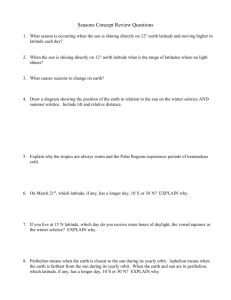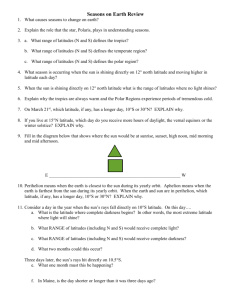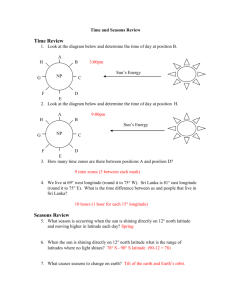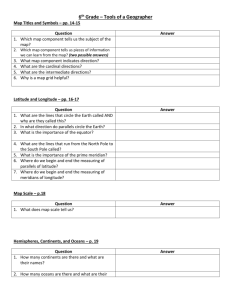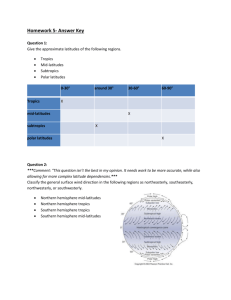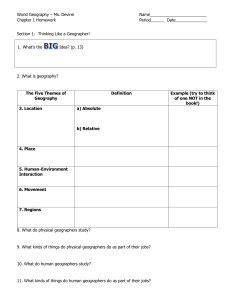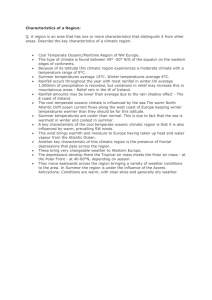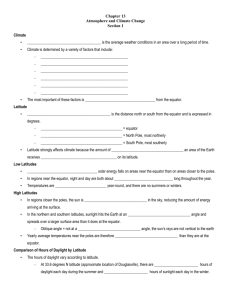Seasons on Earth Review ANSWERS 2012-2013
advertisement
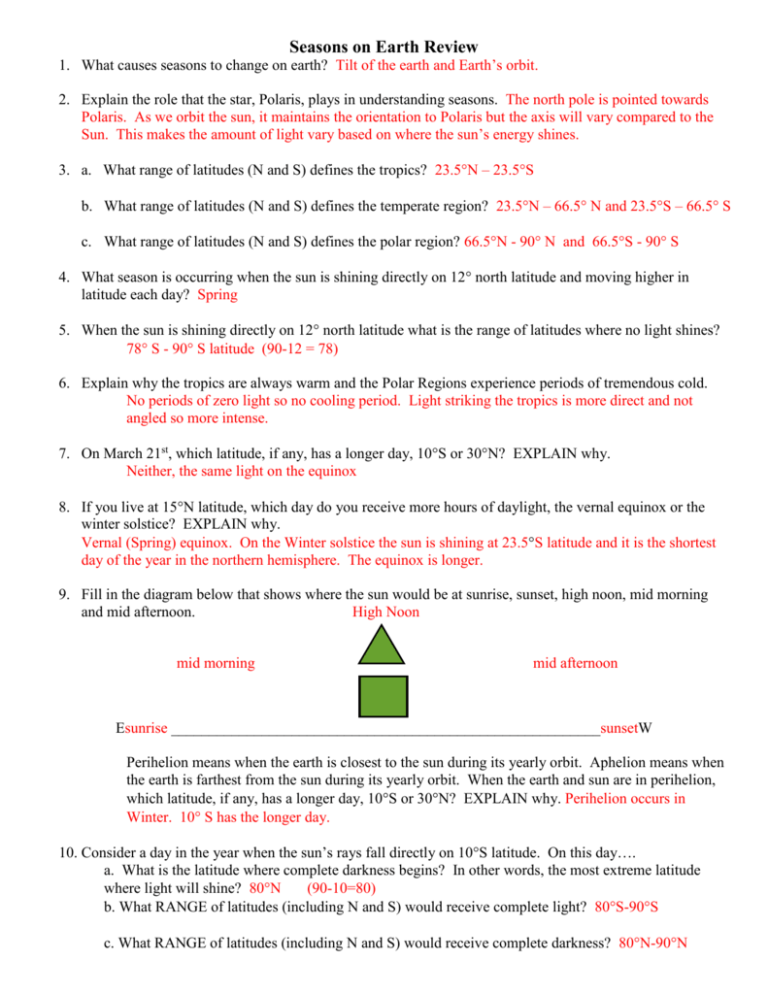
Seasons on Earth Review 1. What causes seasons to change on earth? Tilt of the earth and Earth’s orbit. 2. Explain the role that the star, Polaris, plays in understanding seasons. The north pole is pointed towards Polaris. As we orbit the sun, it maintains the orientation to Polaris but the axis will vary compared to the Sun. This makes the amount of light vary based on where the sun’s energy shines. 3. a. What range of latitudes (N and S) defines the tropics? 23.5N – 23.5S b. What range of latitudes (N and S) defines the temperate region? 23.5N – 66.5 N and 23.5S – 66.5 S c. What range of latitudes (N and S) defines the polar region? 66.5N - 90 N and 66.5S - 90 S 4. What season is occurring when the sun is shining directly on 12 north latitude and moving higher in latitude each day? Spring 5. When the sun is shining directly on 12 north latitude what is the range of latitudes where no light shines? 78 S - 90 S latitude (90-12 = 78) 6. Explain why the tropics are always warm and the Polar Regions experience periods of tremendous cold. No periods of zero light so no cooling period. Light striking the tropics is more direct and not angled so more intense. 7. On March 21st, which latitude, if any, has a longer day, 10S or 30N? EXPLAIN why. Neither, the same light on the equinox 8. If you live at 15N latitude, which day do you receive more hours of daylight, the vernal equinox or the winter solstice? EXPLAIN why. Vernal (Spring) equinox. On the Winter solstice the sun is shining at 23.5S latitude and it is the shortest day of the year in the northern hemisphere. The equinox is longer. 9. Fill in the diagram below that shows where the sun would be at sunrise, sunset, high noon, mid morning and mid afternoon. High Noon mid morning mid afternoon Esunrise _________________________________________________________sunsetW Perihelion means when the earth is closest to the sun during its yearly orbit. Aphelion means when the earth is farthest from the sun during its yearly orbit. When the earth and sun are in perihelion, which latitude, if any, has a longer day, 10S or 30N? EXPLAIN why. Perihelion occurs in Winter. 10 S has the longer day. 10. Consider a day in the year when the sun’s rays fall directly on 10S latitude. On this day…. a. What is the latitude where complete darkness begins? In other words, the most extreme latitude where light will shine? 80N (90-10=80) b. What RANGE of latitudes (including N and S) would receive complete light? 80S-90S c. What RANGE of latitudes (including N and S) would receive complete darkness? 80N-90N d. What two months could this occur? February or October Three days later, the sun’s rays hit directly on 10.5S. e. What one month must this be happening? October f. In Maine, is the day shorter or longer than it was three days ago? Shorter 11. Explain why the amount of light we receive each day varies in Maine. When the sun is shining directly on the equator all locations on earth receive equal minutes of light. As the sun shines north of the equator on its journey to the tropic of Cancer the amount of light increases each day. As the sun shines south of the equator on its journey to the tropic of Capricorn the amount of light decreases each day. 12. Explain why the southern hemisphere has winter when we in the northern hemisphere have summer. When we (Northern Hemisphere) are tilted towards and receiving lots of light energy the Southern Hemisphere is tilted away from the sun and receiving much less light energy. 13. What season are we (in Maine) experiencing when the Earth is in perihelion? Winter 14. Explain why it is warm in the summer and cold in the winter in Maine. Summer we have very long light days and the atmosphere can warm up. In the Winter we have very short light days and the atmosphere cools. Also, the N. Hemi has very little light energy with polar regions getting no light energy while the S. Hemi gets much more light energy with the polar region getting 100% energy for periods. 15. Explain why it is warm in summer and colder in winter in Canada. Canada is nearer to the polar regions yet still in the temperate. They receive ample summer light energy to warm them and the polar region receives LOTS of light energy making Summer warm. In the Winter just the opposite. 16. Explain why Florida has very hot summers and warm winters. Florida is nearer to the Tropics which receives direct and constant light all year long. There are no cooling periods. As a result the Winters are warm and the Summers hot because of the solar cycle. In Summer the direct light is nearer to the latitude of Florida. 17. Maine is at 45 N latitude. This is exactly half way between the equator and north pole. What do you think our location has on influencing our temperatures? There is a constant battle between the polar region and the tropics. Weather can change dramatically, especially in Winter. Frigid air from the North can win or warm air from the South can take over. “ Just wait... the weather will change” 18. Where do cold air masses develop in the northern hemisphere? North in the Polar regions 19. Where do warm air masses develop in the northern hemisphere? South in the tropic regions 20. How would this be different if you lived in the southern hemisphere? The cold air masses develop in the Southern Polar regions and the warm air masses develop in the warm, northern regions. 21. Every place on Earth receives the same amount of light over the course of the year. Explain how this statement makes sense. Some places (polar regions) receive all their light at once and long periods of little to no light and the tropics has similar amount of light all year long. The tropics always receive more intense light compared to the polar regions but not minutes of light. 22. The diagram below shows the sun path at different times of the year. Explain the position of the changes through the seasons. The sun is lower on the horizon in the Winter and higher on the horizon in the Summer because of the tilt and revolution of the Earth around the sun.
